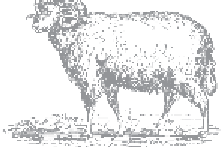Agriculture Reference
In-Depth Information
9
GOOD MANAGEMENT FOR REPRODUCTION is a key to profi tability
and peace of mind. Reproduction really goes right through lambing, but I've
broken the topic into two chapters: this chapter covers the ram, the ewe,
breeding, and pregnancy, and the next chapter covers lambing and early-life
management of your fl ock. The optimal time for lambing varies greatly among
geographical areas. The desired lambing time may depend on the availability
of pasture, local weather conditions, labor and time restraints, targeted lamb
markets, and so on. Choose your lambing time to fi t your priorities, and plan
to breed about 5 months before you want lambs.
When the cost of hay or grain is a consideration or if you want to minimize
labor, lambing should be timed to take advantage of new pasture growth.
Some shepherds living in areas with moderate winters and hot summers may
choose to lamb in autumn or early winter to maximize weight gains, knowing
that lambs experience very poor weight gain in hot temperatures. Those in
the northern areas often begin lambing in March or April to avoid the severe
subzero temperatures of midwinter. People in temperate coastal climates may
let the rams run with the ewes all year and let nature take its course, if they
have no target date for market lambs. What constitutes “early” or “late” lamb-
ing depends on your climate.
Many factors can infl uence how good your breeding season is:
■
Day length.
All sheep are photosensitive, meaning that reproductive
activity is affected by the length of daylight. In the fall and winter,
261

